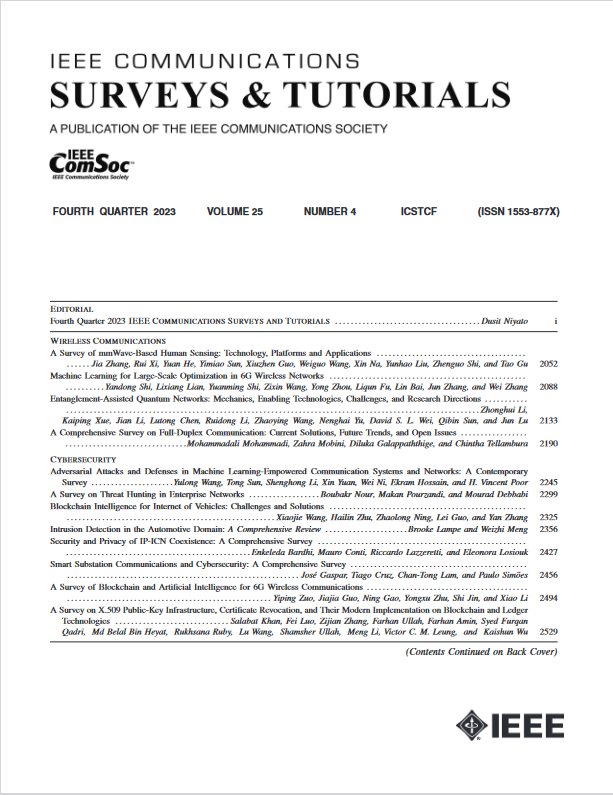Multi-Satellite MIMO Systems for Direct Satellite-to-Device Communications: A Survey
IF 34.4
1区 计算机科学
Q1 COMPUTER SCIENCE, INFORMATION SYSTEMS
引用次数: 0
Abstract
Advancements in satellite technology have made direct satellite-to-device connectivity a viable solution for ensuring global access. This method is designed to provide Internet connectivity to remote, rural, or underserved areas where traditional cellular or broadband networks are lacking or insufficient. This paper is a survey providing an in-depth review of multi-satellite Multiple Input Multiple Output (MIMO) systems as a potential solution for addressing the link budget challenge in direct satellite-to-device communication. Special attention is given to works considering multi-satellite MIMO systems, both with and without satellite collaboration. In this context, collaboration refers to sharing data between satellites to improve the performance of the system. This survey starts by highlighting the industry’s views on the importance of enabling the direct satellite-to-device communications. It follows by explaining several fundamental aspects of satellite communications (SatComs), which are vital prerequisites before investigating the multi-satellite MIMO systems. These aspects encompass satellite orbits, the structure of satellite systems, SatCom links, including the inter-satellite links (ISL) which facilitate satellite cooperation, satellite frequency bands, satellite antenna design, and satellite channel models, which should be known or estimated for effective data transmission to and from multiple satellites. Furthermore, this survey distinguishes itself by providing more comprehensive insights in comparison to other surveys. It specifically delves into the Orthogonal Time Frequency Space (OTFS) within the channel model section. It goes into detail about ISL noise and ISL channel model, and it extends the ISL section by thoroughly investigating hybrid FSO/RF ISLs. Furthermore, analytical comparisons of simulation results from these works are presented to highlight the advantages of employing multi-satellite MIMO systems.用于卫星到设备直接通信的多卫星 MIMO 系统:调查
卫星技术的进步使卫星到设备的直接连接成为确保全球接入的可行解决方案。这种方法旨在为偏远、农村或服务不足的地区提供互联网连接,这些地区缺乏或不足传统的蜂窝或宽带网络。本文是一项深入回顾多卫星多输入多输出(MIMO)系统作为解决直接卫星到设备通信链路预算挑战的潜在解决方案的调查。特别注意考虑多卫星MIMO系统的工作,包括有和没有卫星协作。在这种情况下,协作是指在卫星之间共享数据,以提高系统的性能。这项调查首先强调了业界对实现直接卫星到设备通信的重要性的看法。随后解释了卫星通信(SatComs)的几个基本方面,这是研究多卫星MIMO系统之前至关重要的先决条件。这些方面包括卫星轨道、卫星系统结构、卫星通信链路(包括促进卫星合作的卫星间链路)、卫星频带、卫星天线设计和卫星信道模型,这些都是为有效地向多颗卫星传输数据而应该知道或估计的。此外,与其他调查相比,本调查的特点是提供了更全面的见解。它专门研究了信道模型部分中的正交时频空间(OTFS)。详细介绍了ISL噪声和ISL信道模型,并通过深入研究FSO/RF混合ISL扩展了ISL部分。此外,还对这些工作的仿真结果进行了分析比较,以突出采用多卫星MIMO系统的优势。
本文章由计算机程序翻译,如有差异,请以英文原文为准。
求助全文
约1分钟内获得全文
求助全文
来源期刊

IEEE Communications Surveys and Tutorials
COMPUTER SCIENCE, INFORMATION SYSTEMS-TELECOMMUNICATIONS
CiteScore
80.20
自引率
2.50%
发文量
84
审稿时长
6 months
期刊介绍:
IEEE Communications Surveys & Tutorials is an online journal published by the IEEE Communications Society for tutorials and surveys covering all aspects of the communications field. Telecommunications technology is progressing at a rapid pace, and the IEEE Communications Society is committed to providing researchers and other professionals the information and tools to stay abreast. IEEE Communications Surveys and Tutorials focuses on integrating and adding understanding to the existing literature on communications, putting results in context. Whether searching for in-depth information about a familiar area or an introduction into a new area, IEEE Communications Surveys & Tutorials aims to be the premier source of peer-reviewed, comprehensive tutorials and surveys, and pointers to further sources. IEEE Communications Surveys & Tutorials publishes only articles exclusively written for IEEE Communications Surveys & Tutorials and go through a rigorous review process before their publication in the quarterly issues.
A tutorial article in the IEEE Communications Surveys & Tutorials should be designed to help the reader to become familiar with and learn something specific about a chosen topic. In contrast, the term survey, as applied here, is defined to mean a survey of the literature. A survey article in IEEE Communications Surveys & Tutorials should provide a comprehensive review of developments in a selected area, covering its development from its inception to its current state and beyond, and illustrating its development through liberal citations from the literature. Both tutorials and surveys should be tutorial in nature and should be written in a style comprehensible to readers outside the specialty of the article.
 求助内容:
求助内容: 应助结果提醒方式:
应助结果提醒方式:


